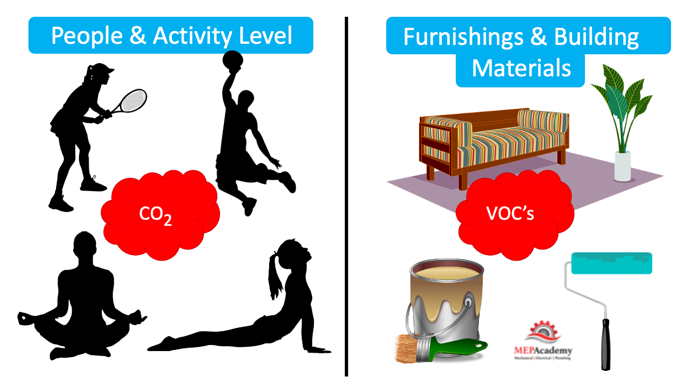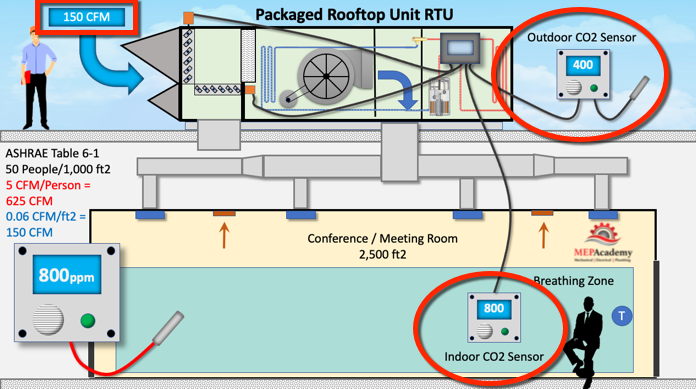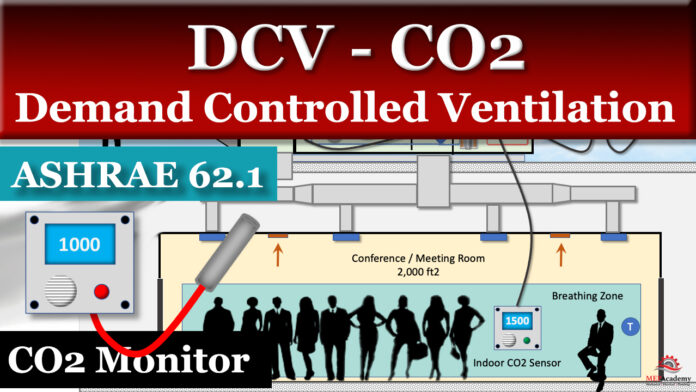Demand Controlled Ventilation (DCV). In this presentation we’ll discuss Demand Controlled Ventilation, and the Controls used to manage the ventilation air. We’ll review the ASHRAE standards 62.1 (Ventilation) and 90.1 (Energy) and how they relate to ventilation. We’ll show you how to use the standards to calculate the required ventilation air rate (CFM) for a space.
If you prefer to watch the YouTube version of this presentation, scroll to the bottom or click on this link. Demand Controlled Ventilation Video
First will show you how a CO2 monitor works in a commercial building using a single zone HVAC system feeding a meeting room. Well show you what happens when the room is empty and what happens when there is too much CO2 in the space.
Sources of Contamination
The sources of contamination in a space comes primarily from two type of sources: The first is the occupants in the space and their activities. The other is off-gassing from furnishings, building materials, adhesives, paints and glues used in construction. The amount of ventilation air to control the contaminants from these two sources is based on a calculation combining these two factors.

If you have a meeting room that is 2,500 square feet, ASHRAE table 6-1 would indicate that there would be 50 people for every 1,000 square feet, which means 125 people for this room at 5 CFM per person for a total of 625 CFM, plus another 0.06 CFM/ft2, adding another 150 CFM, for a total of 775 CFM of ventilation air required for this space.
But what happens when there is only one person in the room, when the system is designed for the maximum occupancy? The system will set the outside air damper at the minimum position, which is 150 CFM.

The Indoor CO2 sensor reads 800 parts per million, which is 400 higher than the Outdoor CO2 reading of 400 parts per million. The world’s average outdoor CO2 level is 419 parts per million.
When a group of people enter the room, the CO2 sensor picks up the increase in carbon dioxide and now reads 950 parts per million. This information is sent to the main controller which sends a signal to the outside air damper to open proportionally. Now the outdoor air dampers opens wider and 250 CFM is entering the meeting room.

More people enter the meeting room causing CO2 levels to increase, and which now reads 1,100 parts per million. The same scenario occurs. A message is sent to the controller, and the outside air damper is again proportionally opened to accommodate the increase in CO2 levels. The outside air is now at 375 CFM.

Again, more people enter the room and the CO2 monitor picks up the increase in CO2 levels to 1250 ppm, and causing the Outside air damper to open further, sending 500 CFM of ventilation air into the space. (Image not shown)

Another group of people attend the meeting and the CO2 level reaches 1400 ppm, outside air damper opens to the maximum setting based on the Ventilation Calculation of 775 CFM.
If additional people keep coming and the CO2 levels reaches 1500, an alarm is set off warning the occupants of an unhealthy level of CO2 in the room. Remember that this alarm can be set at a lower level.

This was just an example, we would hope that the Ventilation Air would be able to dilute the CO2 levels as designed without having to reach an alarm level, but if the outside air damper or it’s actuator weren’t functioning properly this would give you an early warning.
For ventilation purposes ASHRAE 62.1 Table 6-1 list various airflow rates required per person based on occupancy type. In a Gym a rate of 20 CFM per person is required, and in a meeting room its 5 CFM per person. The discrepancy is based on the anticipated activity level, in a meeting people are inactive, most likely sitting in a chair, while in a Gym, people are exercising, strenuously exerting themselves, raising their activity level and giving off more Carbon Dioxide.
The other component of the calculation is based on the square footage of the space, and this is to cover off-gassing and other building material contaminants. For the Meeting Room the area factor is 0.06 CFM/Ft2and for the Gym the area factor is 0.18 CFM/Ft2
Now will see when is Demand Controlled Ventilation required according to ASHRAE 90.1-2019, section 6.4.3.8 Ventilation Controls for High-Occupancy Areas.
Demand Control Ventilation (DCV) is required for spaces larger than 500 ft2 and with a design occupancy for ventilation of ≥25 people per 1,000 ft2 of floor area and served by systems with one or more of the following:
- Air economizer
- Automatic modulating control of outdoor air, and
- Design outdoor airflow greater than 3,000 cfm
The Benefits of Using Demand Control Ventilation are
- Improved health and employee satisfaction
- Better indoor air quality with accurate CO2 monitoring
- Reduction in energy use
- Reduction in operating and maintenance cost
- Increased energy efficiency







